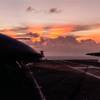USS John C. Stennis (CVN 74) and embarked Carrier Air Wing (CVW) 9 returned to the North Arabian Sea June 14 following its third port visit in the Middle East.
Starting June 15, CVW-9 will conduct missions in support of Operation Enduring Freedom (OEF) and will provide close air-power support and reconnaissance to International Security Assistance Force (ISAF) troops on the ground in Afghanistan. ISAF is comprised of more than 35,000 troops, with contributions from 37 nations.
“We have met every operational commitment assigned to perfection and have maintained a level of operational readiness second to none,” said Stennis’ Commanding Officer, Capt. Brad Johanson. “Our support to the troops on the ground has made a decisive difference in the region.”
As a Combined Forces Air Component Command (CFACC) asset, CVW-9 integrates closely with multinational coalition forces to prevent and counter Taliban attacks. Carrier aircraft provide close air-power support and deliver ordnance on enemy positions designated by ground forces.
“CVW-9 will be providing a variety of effects, both kinetic and non-kinetic,” said Capt. Sterling Gilliam, commander, CVW-9. “We will be tasked with close air support, reconnaissance and other tactical missions while operating in support of OEF.”
Since arriving in the U.S. 5th Fleet area of operations, CVW-9 has flown over 9,000 hours and has provided more than 65,000 pounds of ordnance in support of coalition forces operating on the ground in Afghanistan and Iraq in approximately 200 engagements.
“Throughout our time here on station we have defeated time and time again the Taliban's efforts to launch significant offensive campaigns,” said Johanson.
“As we continue to support troops on the ground in Afghanistan we revalidate the importance of coalition forces in bringing stability and security to this critical region.”
Stennis and its strike group entered the Persian Gulf May 23, along with the USS Nimitz (CVN 68) Carrier Strike Group and the USS Bonhomme Richard (LHD 6) Expeditionary Strike Group.
While operating in the Arabian Gulf, the three strike groups performed Expeditionary Strike Force (ESF) training along with conducting missions in direct support of Operation Iraqi Freedom (OIF).
It was the first time Stennis, Nimitz and Bonhomme Richard strike groups operated together in the U.S. 5th Fleet area of operations.
The ESF training demonstrated the importance of the strike groups’ ability to plan and conduct multi-task force operations as part of the U.S.’s long-standing commitment to maintaining maritime security and stability in the region.
Stennis left its homeport of Bremerton, Wash., Jan. 16 for a regularly scheduled deployment and began operating with coalition forces in 5th Fleet Feb. 19.
The John C. Stennis Carrier Strike Group (JCSSG) has provided direct support to coalition ground forces participating in OEF and OIF, as well as conducting maritime operations.
Maritime operations help set the conditions for security and stability in the maritime environment, as well as complement the counter-terrorism and security efforts of regional nations. These operations deny international terrorists the use of the maritime environment as a venue for attack or to transport personnel, weapons or other material.
The CVW-9 squadrons include the “Black Knights” of Strike Fighter Squadron (VFA) 154, “Blue Diamonds” of VFA 146, “Argonauts” of VFA 147, “Death Rattlers” of Marine Strike Fighter Squadron 323, “Yellow Jackets” of Electronic Attack Squadron 138, “Golden Hawks” of Carrier Airborne Early Warning Squadron 112, “Topcats” of Sea Control Squadron 31, “Eightballers” of Helicopter Anti-Submarine Squadron 8 and “Providers” of Fleet Logistics Support Squadron 30.
By Lt. Nathan Christensen, USS John C. Stennis Public Affairs
JCSSG includes Stennis, CVW-9, Destroyer Squadron 21, USS Antietam (CG 54), the guided-missile destroyers USS O’Kane (DDG 77) and USS Preble (DDG 88) and the fast combat-support ship USNS Bridge (T-AOE 10). More than 6,500 Sailors and Marines are assigned to JCSSG.
Featured videos

Inside the Electrified Truckable Tug

Tracking Foreign Vessels Working in the U.S. Jones Act Market

Inmarsat Enhances Service to Drive Digitalization
Subscribe for
Maritime Reporter E-News
Maritime Reporter E-News is the maritime industry's largest circulation and most authoritative ENews Service, delivered to your Email five times per week









